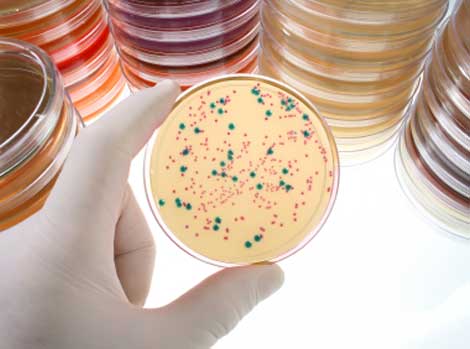Tailing blunt-ended DNA fragments with TaqDNA Polymerase allows efficient cloning of these fragments into T-Vectors such as the pGEM®-T Vectors. This method also eliminates some of the requirements of conventional blunt-end cloning — Fewer steps, who can argue with that?

Traditionally, efficient cloning of blunt-ended fragments into a vector required several steps. The vector needed to be dephosphorylated with either Calf Intestinal Alkaline Phosphatase (CIAP) or bacterial alkaline phosphatase. Dephosphorylatig the vector kept it from religating to itself; it also meant you had to purify the vector before you could proceed with the ligation step. In addition, you often had to modify your ligation buffer by adding polyethylene glycol (to crowd the molecules together) and a low amount of ATP. And then you had to use high concentrations of T4 DNA Ligase and lots and lots of your precious insert.
Tailing your blunt-ended insert with TaqDNA Polymerase and cloning it into a T-Vector eliminates a number of these steps. You do not need to dephosphorylate your vector, and so there is no need to purify it. It is also unlikely that you will have to muck about with your ligation buffer. And even though the recommended molar ratio of insert to vector falls anywhere between 8:1 and 1:8, it is unlikely you will end up using more insert than you would have with blunt-end cloning.
Can’t wait to get started? Here is what you do.
Blunt-ended restriction digest products
- Use 1–2µl of the DNA fragment.
- Add 1µl of Taq DNA Polymerase Reaction 10X Buffer.
- Add 1µl of 25mM MgCl2
- Add dATP to a final concentration of 0.2mM.
- Add 5 units of Taq DNA Polymerase.
- Add Nuclease-Free Water to a final volume of 10µl.
- Incubate at 70°C for 30 minutes.
Blunt-ended PCR Fragments
Are you wondering if there is a way to tail your blunt-ended PCR fragments that were amplified with a proofreading DNA polymerase like Pfu DNA polymerase? Of course there is, and here is what you do.
- Use 1–7µl of purified PCR fragment.Note: The fragment must be purified or the proofreading enzyme will continue to remove the A-overhangs created by the Taq DNA Polymerase.
- Add 1µl Taq DNA Polymerase 10X Reaction Buffer with MgCl2.
- Add dATP to a final concentration of 0.2mM.
- Add 5 units of Taq DNA Polymerase.
- Add Nuclease-Free Water to a final volume of 10µl.
- Incubate at 70°C for 15–30 minutes.
- Use 1–2µl in a ligation reaction.
The A-tailed fragments can be cloned directly into the pGEM®-T vectors without further purification. Intrested in saving a bit more time? Consider using the pGEM®-T Easy Vector System, which allows you to remove your insert with a single BstZI, EroRI or NotI digest.
Want to learn more? The Cloning chapter of the Protocols and Applications Guide (Promega) have a lot of useful information.
Related Posts
Kelly Grooms
Latest posts by Kelly Grooms (see all)
- Growing Our Understanding of Triple-Negative Breast Cancer in Sub-Saharan Africa: Why Comprehensive Population Data Matters - June 5, 2025
- Measles and Immunosuppression—When Getting Well Means You Can Still Get Sick - April 17, 2025
- IC50, EC50 and Kd: What is the Difference and Why Do They matter? - March 6, 2025

I’m wondering why the protocol is apparently duplicated in this posting. It’s confusing!
Hi Teresa,
Thank you for your comment. The first protocol is for blunt-ended fragments from restriction digests; the second is for PCR products amplified with a polymerase that produces blunt ends. The important difference is that the PCR product must be purified before it is tailed. We also recomend using more of the amplified product than the restriction digested fragment.
I will update the headings to try to eliminate the confusion.
It is possible to make a partial genomic library (fragments between .8-1 KB), digesting my genomic DNA with a blut end enzyme, tailing with Taq + dATP and ligation to pGEM-T?
Hi Alejandro,
Yes, it is possible to create a genomic library using the pGEM®-T Vector if your blunt-ended restriction enzyme fragments are A tailed. You may find the following reference helpful:
Kawata, Y., Yano, S., and H. Kojima (1998) Construction of a genomic DNA library by TA cloning. BioTechniques 24, 564–5.
If you have further questions, please contact our Technical Services Scientists.
Hello Promega! How can I efficiently perform TA ligation of quite large (6kb and 8kb) of Pfu-generated PCR product with any plasmid vector?